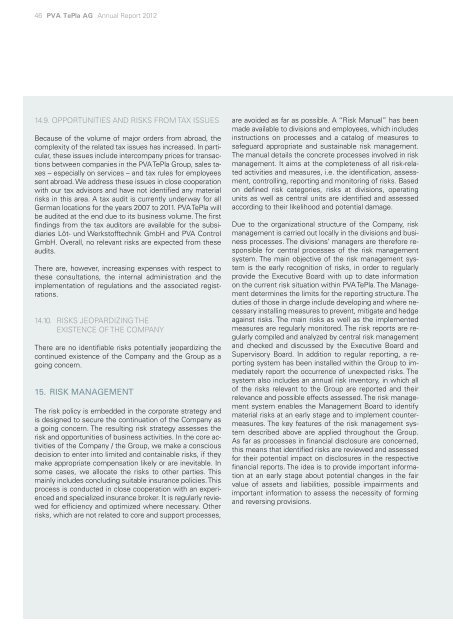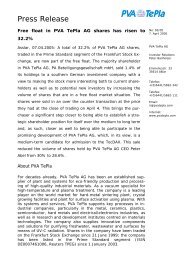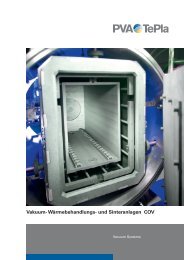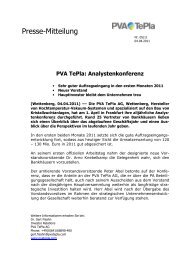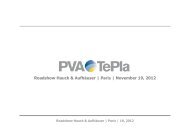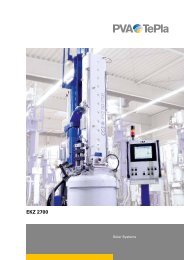Consolidated Annual Report 2012 and Single-Entity ... - PVA TePla AG
Consolidated Annual Report 2012 and Single-Entity ... - PVA TePla AG
Consolidated Annual Report 2012 and Single-Entity ... - PVA TePla AG
You also want an ePaper? Increase the reach of your titles
YUMPU automatically turns print PDFs into web optimized ePapers that Google loves.
46 <strong>PVA</strong> <strong>TePla</strong> <strong>AG</strong> <strong>Annual</strong> <strong>Report</strong> <strong>2012</strong><br />
14.9. OPPORTUNITIES AND RISKS FROM TAX ISSUES<br />
Because of the volume of major orders from abroad, the<br />
complexity of the related tax issues has increased. In particular,<br />
these issues include intercompany prices for transactions<br />
between companies in the <strong>PVA</strong> <strong>TePla</strong> Group, sales taxes<br />
– especially on services – <strong>and</strong> tax rules for employees<br />
sent abroad. We address these issues in close cooperation<br />
with our tax advisors <strong>and</strong> have not identified any material<br />
risks in this area. A tax audit is currently underway for all<br />
German locations for the years 2007 to 2011. <strong>PVA</strong> <strong>TePla</strong> will<br />
be audited at the end due to its business volume. The first<br />
findings from the tax auditors are available for the subsidiaries<br />
Löt- und Werkstofftechnik GmbH <strong>and</strong> <strong>PVA</strong> Control<br />
GmbH. Overall, no relevant risks are expected from these<br />
audits.<br />
There are, however, increasing expenses with respect to<br />
these consultations, the internal administration <strong>and</strong> the<br />
implementation of regulations <strong>and</strong> the associated registrations.<br />
14.10. RISKS JEOPARDIZING THE<br />
EXISTENCE OF THE COMPANY<br />
There are no identifiable risks potentially jeopardizing the<br />
continued existence of the Company <strong>and</strong> the Group as a<br />
going concern.<br />
15. RISk MAN<strong>AG</strong>EMENT<br />
The risk policy is embedded in the corporate strategy <strong>and</strong><br />
is designed to secure the continuation of the Company as<br />
a going concern. The resulting risk strategy assesses the<br />
risk <strong>and</strong> opportunities of business activities. In the core activities<br />
of the Company / the Group, we make a conscious<br />
decision to enter into limited <strong>and</strong> containable risks, if they<br />
make appropriate compensation likely or are inevitable. In<br />
some cases, we allocate the risks to other parties. This<br />
mainly includes concluding suitable insurance policies. This<br />
process is conducted in close cooperation with an experienced<br />
<strong>and</strong> specialized insurance broker. It is regularly reviewed<br />
for efficiency <strong>and</strong> optimized where necessary. Other<br />
risks, which are not related to core <strong>and</strong> support processes,<br />
are avoided as far as possible. A “Risk Manual” has been<br />
made available to divisions <strong>and</strong> employees, which includes<br />
instructions on processes <strong>and</strong> a catalog of measures to<br />
safeguard appropriate <strong>and</strong> sustainable risk management.<br />
The manual details the concrete processes involved in risk<br />
management. It aims at the completeness of all risk-related<br />
activities <strong>and</strong> measures, i.e. the identification, assessment,<br />
controlling, reporting <strong>and</strong> monitoring of risks. Based<br />
on defined risk categories, risks at divisions, operating<br />
units as well as central units are identified <strong>and</strong> assessed<br />
according to their likelihood <strong>and</strong> potential damage.<br />
Due to the organizational structure of the Company, risk<br />
management is carried out locally in the divisions <strong>and</strong> business<br />
processes. The divisions’ managers are therefore responsible<br />
for central processes of the risk management<br />
system. The main objective of the risk management system<br />
is the early recognition of risks, in order to regularly<br />
provide the Executive Board with up to date information<br />
on the current risk situation within <strong>PVA</strong> <strong>TePla</strong>. The Management<br />
determines the limits for the reporting structure. The<br />
duties of those in charge include developing <strong>and</strong> where necessary<br />
installing measures to prevent, mitigate <strong>and</strong> hedge<br />
against risks. The main risks as well as the implemented<br />
measures are regularly monitored. The risk reports are regularly<br />
compiled <strong>and</strong> analyzed by central risk management<br />
<strong>and</strong> checked <strong>and</strong> discussed by the Executive Board <strong>and</strong><br />
Supervisory Board. In addition to regular reporting, a reporting<br />
system has been installed within the Group to immediately<br />
report the occurrence of unexpected risks. The<br />
system also includes an annual risk inventory, in which all<br />
of the risks relevant to the Group are reported <strong>and</strong> their<br />
relevance <strong>and</strong> possible effects assessed. The risk management<br />
system enables the Management Board to identify<br />
material risks at an early stage <strong>and</strong> to implement countermeasures.<br />
The key features of the risk management system<br />
described above are applied throughout the Group.<br />
As far as processes in financial disclosure are concerned,<br />
this means that identified risks are reviewed <strong>and</strong> assessed<br />
for their potential impact on disclosures in the respective<br />
financial reports. The idea is to provide important information<br />
at an early stage about potential changes in the fair<br />
value of assets <strong>and</strong> liabilities, possible impairments <strong>and</strong><br />
important information to assess the necessity of forming<br />
<strong>and</strong> reversing provisions.


